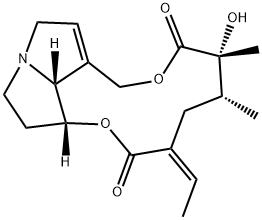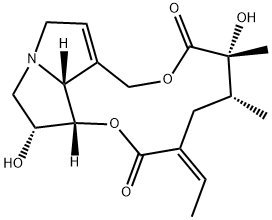PRODUCT Properties
| Melting point: | 236 °C(lit.) |
| alpha | D25 -55.1° (c = 0.034 in chloroform) |
| Boiling point: | 472.03°C (rough estimate) |
| Density | 1.266 g/cm3 |
| refractive index | 1.5100 (estimate) |
| storage temp. | −20°C |
| solubility | DMF: 5 mg/ml; DMSO: 2 mg/ml; Ethanol: 1 mg/ml; PBS (pH 7.2): 0.1 mg/ml |
| form | Solid |
| pka | 12.81±0.40(Predicted) |
| color | White to off-white |
| optical activity | [α]25/D 55.1°, c = 0.034% in chloroform |
| BRN | 8162955 |
| InChIKey | HKODIGSRFALUTA-JTLQZVBZSA-N |
| LogP | 0.880 (est) |
| EPA Substance Registry System | Senecionine (130-01-8) |
Description and Uses
This hepatotoxic alkaloid is widely distributed among the Senecio species, being found in S. aureus, S. ilicifolius Thunb., S. integerrirnus, S. pseudaarnica, S. squaUdus, S. viscosus and S. vulgaris. The base is laevorotatory with [α]D - 54.6° (CHCI3 ) and the crystals sublime at 130-140°CfO.2 mm. The nitrate has m.p. 214°C;[α]D - 34.2° (H2 0); the aurichloride, m.p. 186°C; the picrate, m.p. 191°C and the methiodide, m.p. 249°C. Alkaline hydrolysis furnishes retronecine and senecic acid (6-hydroxy-5-methyl-2-heptene-3 :6-dicarboxylic acid).
Senecionine is a pyrrolizidine alkaloid with the potential to affect hepatic drug metabolizing enzymes in rat cells.
Safety
| Symbol(GHS) |  GHS06 |
| Signal word | Danger |
| Hazard statements | H300+H310+H330 |
| Precautionary statements | P262-P280-P301+P310+P330-P302+P352+P310-P304+P340+P310 |
| Hazard Codes | T |
| Risk Statements | 25 |
| Safety Statements | 45 |
| RIDADR | UN 2811 6.1/PG 3 |
| WGK Germany | 3 |
| RTECS | VT5710000 |
| F | 10-23 |
| HazardClass | 6.1(a) |
| PackingGroup | II |
| Hazardous Substances Data | 130-01-8(Hazardous Substances Data) |
| Toxicity | LD50 i.v. in mice: 64.12 ±2.24 mg/kg (Harris) |





